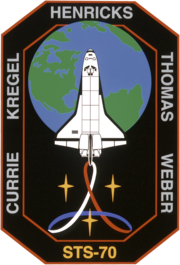STS-70

Discovery prepares to deploy the TDRS-G satellite
|
|||||
| Mission type | Satellite deployment | ||||
|---|---|---|---|---|---|
| Operator | NASA | ||||
| COSPAR ID | 1995-035A | ||||
| SATCAT № | 23612 | ||||
| Mission duration | 8 days, 22 hours, 20 minutes, 05 seconds | ||||
| Distance travelled | 6,000,000 kilometres (3,700,000 mi) | ||||
| Orbits completed | 143 | ||||
| Spacecraft properties | |||||
| Spacecraft | Space Shuttle Discovery | ||||
| Payload mass | 20,159 kilograms (44,443 lb) | ||||
| Crew | |||||
| Crew size | 5 | ||||
| Members |
Terence T. Henricks Kevin R. Kregel Nancy J. Currie Donald A. Thomas Mary Ellen Weber |
||||
| Start of mission | |||||
| Launch date | 13 July 1995, 13:41:55.078 UTC | ||||
| Launch site | Kennedy LC-39B | ||||
| End of mission | |||||
| Landing date | 22 July 1995, 12:02 UTC | ||||
| Landing site | Kennedy SLF Runway 33 | ||||
| Orbital parameters | |||||
| Reference system | Geocentric | ||||
| Regime | Low Earth | ||||
| Perigee | 257 kilometres (160 mi) | ||||
| Apogee | 257 kilometres (160 mi) | ||||
| Inclination | 28.45 degrees | ||||
| Period | 90.5 min | ||||
|
|
|||||


Left to right: Kregel, Currie, Henricks; Weber, Thomas
STS-70 was the 21st flight of the Space Shuttle Discovery, and the last of 7 shuttle missions to carry a Tracking and Data Relay Satellite (TDRS). This was the first shuttle mission controlled from the new mission control center room at the Johnson Space Center in Houston. STS-70 was also the first flight of the new Block 1 orbiter main engine, designed to improve both engine performance and safety. The mission was launched from Kennedy Space Center in Florida on 13 July 1995, only six days after the landing of sister ship Atlantis, marking the fastest turnaround between flights in the history of the program.
STS-70 had originally moved ahead of STS-71 because of a delay in the launch of the Russian Spektr laboratory module to the Russian space station Mir. However, on 31 May 1995 shuttle managers assessed damage to the External Tank of STS-70 caused by nesting flicker woodpeckers. The damage consisted of about 71 holes (ranging in size from 4 inches in diameter to 1/2 inch in diameter) in the ETs thermal protection foam insulation. Technicians installed safeguards against additional damage. On 2 June, NASA managers decided to delay the launch of Discovery in order to make repairs to the insulation, and STS-71 was moved ahead of STS-70. Discovery was rolled back to the VAB on 8 June, and was returned to the pad on 15 June. Launch occurred 13 July 1995 at 9:41:55.078 a.m. EDT. The launch window was 2 hours 30 min. The hatch was closed at 8:13am EDT and the count proceeded smoothly until T-31 sec. The count was held for 55 seconds at T-31 sec by the Booster Range Safety Engineer (CBRS) Tod Gracom at the LCC C-5 Console due to fluctuations seen on the external tank automatic gain control (AGC) ET range safety system receiver . Launch Commit Criteria contigency procedures were worked and the count then proceeded on schedule. STS-70 marked the maiden flight of the new Block 1 orbiter main engine. Engine number 2036 featured the new high-pressure liquid oxygen turbopump, a two-duct powerhead, baffleless main injector, single-coil heat exchanger and start sequence modifications. The Block I engine flew in the number one position on Discovery. The other two engines were of the existing Phase II design.
...
Wikipedia
